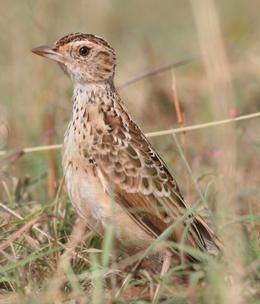
© IUCN/Greg Davies.Sidamo lark, edging towards extinction.
July 2013. Declines in birds across the globe are providing evidence of a rapid deterioration in the global environment that is affecting all life on earth - including people. However, birds also tell us that saving the planet comes at a relatively small price - an investment that's vital to secure our own future.
These are some of the messages in a new report
State of the World's Birds: indicators for our changing world by BirdLife International, an IUCN Red List partner, who gathered last week in Ottawa, Canada to launch the report and unveil their vision for a world rich in biodiversity, where people and nature live in harmony.
Many species slipping towards extinctionThe status of the world's birds continues to get worse with many species slipping towards extinction and others in steep decline.
Birds are facing threats on many fronts but habitat destruction and degradation, owing to changes in agriculture, as well as direct impacts from invasive species are the major causes. However, birds also provide a lens through which we can view all nature.
"Birds provide an accurate and easy to read environmental barometer that allows us to see clearly the pressures our current way of life are putting on the world's biodiversity", said Dr Leon Bennun, BirdLife's Director of Science, Information and Policy.
12,000 Important Bird and Biodiversity AreasThe BirdLife Partnership has identified the most important places for nature. These are called Important Bird and Biodiversity Areas - IBAs for short. Over 12,000 have now been documented, with major recent advances in identifying IBAs in the marine environment.
IBAs represent the largest systematically identified global network of important sites for biodiversity but only 28% are completely covered by existing protected areas. Effectively protecting and managing all IBAs would cost $57.8 billion per year. Combined with the cost of actions to improve the status of threatened species in all wildlife groups, conserving nature has been estimated to cost US$80 billion per year.
Return on investment"The total sums may sound large, but they are small in terms of government budgets, and they should be seen as investments, not bills - saving nature makes economic sense because of the payback in terms of services and benefits that people receive in return, from mitigating climate change to pollinating crops", said Dr Stuart Butchart, BirdLife's Head of Science.
"More fundamentally, biodiversity underpins our planetary life-support systems - in order to survive and prosper, we have to look after it."
The positive message from the report is that conservation works. Where threats are tackled through focused interventions, conservation can succeed. Some species have been brought back from the brink of extinction in spectacular fashion and degraded habitats can be restored.
"Effective nature conservation is affordable and it works. It's time to make it happen. The result will be a world that is in every way wealthier and healthier - and that remains diverse and beautiful too," concluded Dr Bennun.
Read the full report

Reader Comments
to our Newsletter